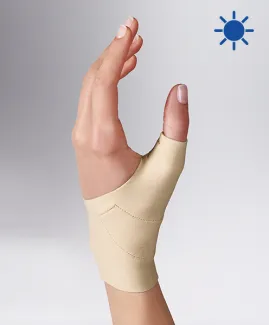
Osteoarthritis (OA) in the thumb precisely affects the trapeziometacarpal joint. It is the most common form of arthritis, so it is often just referred to as thumb arthritis. This condition mostly affects women over 50. Thumb OA often starts by the dominant hand, but both hands are usually affected.
Many factors increase the risk of developing OA: some are modifiable osteoarthritis risk factors and others just can’t be prevented. Find out the 6 most significant risk factors for osteoarthritis in the thumb in order to fight them better.
What are the 6 most significant thumb osteoarthritis risk factors?
The majority of risk factors for osteoarthritis in the thumb can’t be prevented. Indeed, most of them are related to ageing, hormones, genetics or anatomy. Indeed, some osteoarthritis risk factors are modifiable like the movements of daily life as well as the way you treat your past injuries. The most common factors that contribute to the development of thumb arthritis include:
1. Age
The prevalence of thumb osteoarthritis increases from 50 years old. The reason is simple: ageing affects the whole body, including the cartilages, which wear out naturally over time. This wear and tear lead to rubbing between two bones: the trapezium and the metacarpal bone, causing pain and stiffness in the long term.
2. Hormonal risk factors of osteoarthritis in the thumb
Hormonal variations during menopause is another risk factor for osteoarthritis in the thumb. It also explains why women are more affected than men. Oestrogens have protective effects on the cartilage. With age, hormone levels decrease: this process contributes to thumb arthritis.
3. Thumb osteoarthritis genetic factors
Genetics means family predisposition. If someone in your family has arthritic thumbs, you are likely to have developed it too. So find out about your family history and feel free to complain to them!
4. Joint hypermobility
If you are flexible by nature, in the joint sense of the term, your joint may suffer from it as you grow older.
5. Risk factors of arthritis related to hard manual work
You have higher risks of developing arthritis in your thumbs if you had or have manual work such as cabinetmaking, sewing, gardening, etc. Indeed, the repetitive and meticulous movements can damage your thumb joint. Moreover, if you add hard working conditions: cold, moisture… those are even more thumb osteoarthritis risk factors.
6. Traumatic risk factors of osteoarthritis in the thumbs
Traumatic injuries of the thumb (e.g.: fracture or sprain consequences) are the last type of risk factors for thumb osteoarthritis. If you had unfortunate experiences with your thumb in the past and if physical therapy hasn’t been optimal, this can later pass on your joint through thumb OA.

Against modifiable risk factors for osteoarthritis, try the EPITACT® thumbs supports
Among the modifiable osteoarthritis risk factors, let’s cite the repetitive and harmful movements we do in daily life.
No matter the cause, the EPITACT® solutions prevent and relieve the pain caused by osteoarthritis in the thumb. The objectives of the braces developed by EPITACT® are different according to the design.
The rigid thumb brace* is intended to be worn at night or during resting periods whereas the flexible thumb brace* has been created for day use or during activities.
Indeed, the first one immobilises the thumb in order to limit the stress on the joint while sleeping. The second one, which is totally flexible, soothing joint pain at the base of the thumb without limiting the hand’s function, especially the thumb-index pinch grip.
In conclusion, there are 6 most significant risk factors for osteoarthritis in the thumb but most of them can’t be prevented. So, as soon as the first symptoms appear, consult your general practitioner and do whatever you can to slow down the progression!
Related article: 7 advice to fight against thumb osteoarthritis
*These solutions are class I medical devices that bear the CE marking under this regulation. Carefully read the instructions before use. Manufacturer: Millet Innovation. 06/2023
 Pharmacie
Pharmacie

